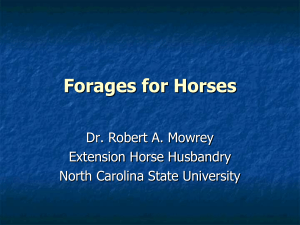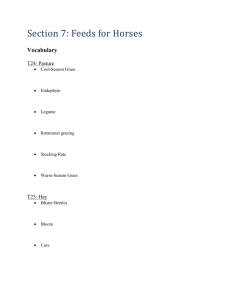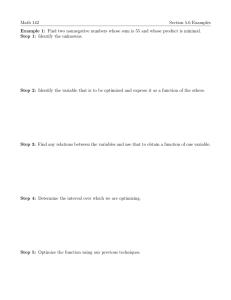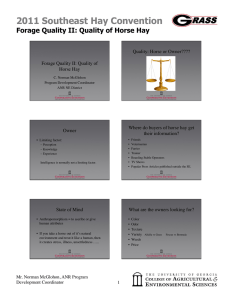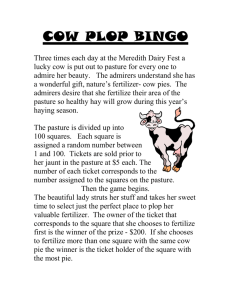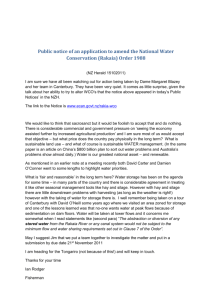Descriptions and Characteristics of Common Horse Pasture Grasses and Legumes
advertisement
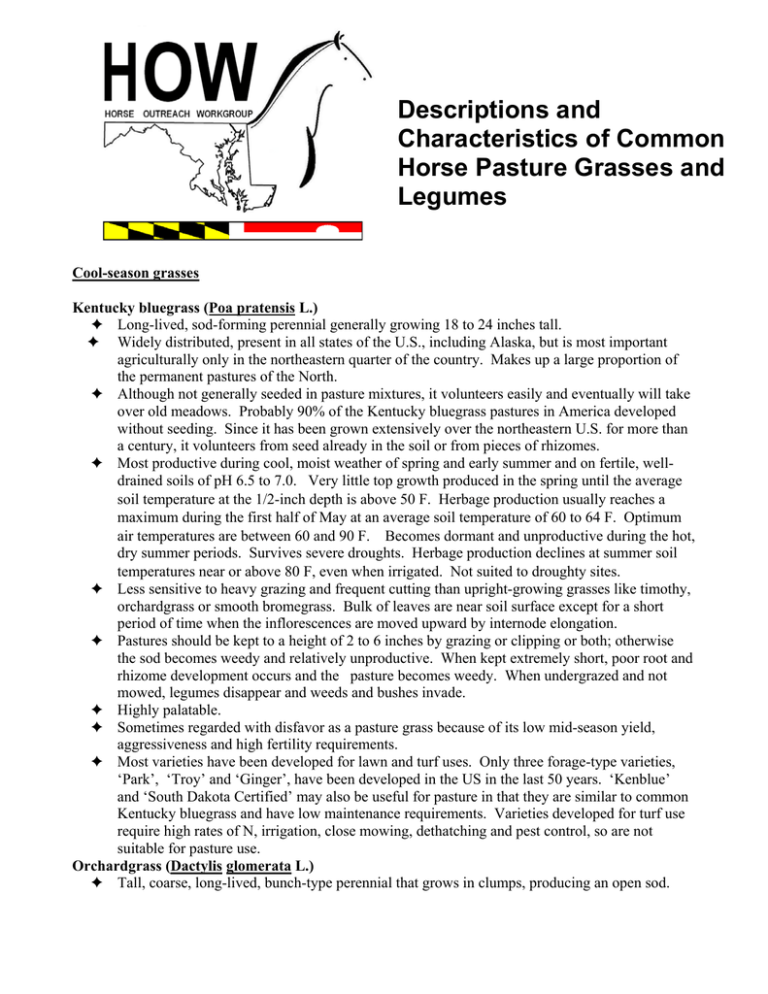
Descriptions and Characteristics of Common Horse Pasture Grasses and Legumes Cool-season grasses Kentucky bluegrass (Poa pratensis L.) g Long-lived, sod-forming perennial generally growing 18 to 24 inches tall. g Widely distributed, present in all states of the U.S., including Alaska, but is most important agriculturally only in the northeastern quarter of the country. Makes up a large proportion of the permanent pastures of the North. g Although not generally seeded in pasture mixtures, it volunteers easily and eventually will take over old meadows. Probably 90% of the Kentucky bluegrass pastures in America developed without seeding. Since it has been grown extensively over the northeastern U.S. for more than a century, it volunteers from seed already in the soil or from pieces of rhizomes. g Most productive during cool, moist weather of spring and early summer and on fertile, welldrained soils of pH 6.5 to 7.0. Very little top growth produced in the spring until the average soil temperature at the 1/2-inch depth is above 50 F. Herbage production usually reaches a maximum during the first half of May at an average soil temperature of 60 to 64 F. Optimum air temperatures are between 60 and 90 F. Becomes dormant and unproductive during the hot, dry summer periods. Survives severe droughts. Herbage production declines at summer soil temperatures near or above 80 F, even when irrigated. Not suited to droughty sites. g Less sensitive to heavy grazing and frequent cutting than upright-growing grasses like timothy, orchardgrass or smooth bromegrass. Bulk of leaves are near soil surface except for a short period of time when the inflorescences are moved upward by internode elongation. g Pastures should be kept to a height of 2 to 6 inches by grazing or clipping or both; otherwise the sod becomes weedy and relatively unproductive. When kept extremely short, poor root and rhizome development occurs and the pasture becomes weedy. When undergrazed and not mowed, legumes disappear and weeds and bushes invade. g Highly palatable. g Sometimes regarded with disfavor as a pasture grass because of its low mid-season yield, aggressiveness and high fertility requirements. g Most varieties have been developed for lawn and turf uses. Only three forage-type varieties, ‘Park’, ‘Troy’ and ‘Ginger’, have been developed in the US in the last 50 years. ‘Kenblue’ and ‘South Dakota Certified’ may also be useful for pasture in that they are similar to common Kentucky bluegrass and have low maintenance requirements. Varieties developed for turf use require high rates of N, irrigation, close mowing, dethatching and pest control, so are not suitable for pasture use. Orchardgrass (Dactylis glomerata L.) g Tall, coarse, long-lived, bunch-type perennial that grows in clumps, producing an open sod. g Adapted to moderately poor to well-drained soils. Is more drought tolerant than timothy or Kentucky bluegrass, but less tolerant than tall fescue, reed canarygrass or smooth bromegrass. g Will persist on shallow, reasonably infertile soils and be moderately productive. Soil requirements are less exacting than those of either timothy or smooth bromegrass. Is responsive to fertilizer applications especially N. In its area of adaptation it becomes the dominant species when an abundance of nutrients are available. At high rates of N, orchardgrass is among the most productive of the cool-season grasses. g Grows rapidly at cool temperatures and is especially productive in early spring. Rapid recovery after cutting or grazing with good summer regrowth if good fertility and adequate moisture are available. Aftermath production contributes from 33 to 66% of total production when split applications of fertilizer are applied. By comparison, aftermath of timothy with similar management and fertility contributes only 20% of total production. More heat tolerant then timothy or Kentucky bluegrass but less so than smooth bromegrass or tall fescue. Reasonably productive in late fall, but less so than tall fescue. g Less winter hardy than reed canarygrass, smooth bromegrass or timothy. Varieties vary in winter hardiness but generally adequate for Maryland. For this reason timothy and smooth bromegrass are grown farther north and at higher elevations than orchardgrass. g Is shade tolerant; grows in areas where there is reduced light. g Starts growth early in spring develops rapidly. g Suited for pasture, hay and silage. Must be cut early for hay or silage, otherwise can be very coarse and stemmy. The open, bunchy orchardgrass sod makes it compatible with alfalfa and other tall-growing legumes. Use late maturing varieties in combination with legumes for hay and silage; these varieties head about the time alfalfa begins to bloom. Late maturing orchardgrass varieties generally survive well with alfalfa cut at the bud to first flower stage of growth because this usually coincides with the boot to early heading stage of these orchardgrass varieties (when food reserves are at a high level in the stem bases). The order of maturity is generally Kentucky bluegrass, orchardgrass, tall fescue, perennial ryegrass, reed canarygrass, smooth bromegrass and timothy. g Usually establishes with ease, more readily than timothy or smooth bromegrass. New seedings develop rather quickly. Emergence of germinated seedlings is favored by short days and by moderate temperatures. Temperatures of 85 F or above greatly reduce emergence. Tall fescue (Festuca arundinacea Schreb) g Tall, deep-rooted, long-lived, bunch-type perennial that has the ability to spread and form a dense sod by means of short rhizomes, especially when kept mowed or grazed. Leaves are shiny, dark green and heavily ribbed. They have rough edges, particularly on older leaves or when growing on low fertility sites. g Adapted to a wide range of soil and climatic conditions. Tolerates soil pH in range of 4.5 to 9.5. Is tolerant of poor drainage, particularly in winter, while also being one of the more drought-resistant grasses suitable for humid regions. g High yielding with good seasonal distribution of growth. Provides more grazing days per year than other tall-growing, cool-season grasses; consequently, can be used to reduce winter feeding costs. Good summer regrowth if moisture and fertility are not limiting, but makes its best growth under relatively cool growing conditions. Has some winter activity, i.e. grows at relatively low temperatures (34 to 40 F). g Can be used for pasture, hay and silage. Must be cut early for hay or silage. Is tolerant of continuous close grazing. Rotational close grazing on well-established stands is a good management practice. Advisable to seed a legume with tall fescue; legumes improve palatability and nutritive value. g Quality is somewhat poorer in late spring and during the summer than most other grasses. Digestibility, total sugar content and palatability is lowest during summer, intermediate in early spring and highest during the fall. High quality during fall months is attributed to an increase in soluble carbohydrates. g Reproductive difficulties of mares grazing some tall fescue pastures are possible. The difficulties include: abortions, prolonged pregnancy, foaling problems that can result in foal and/or mare deaths, thick or retained placentas, and aglactia (little or no milk production after foaling). The problems are associated with a certain type of toxic fungus that grows within the fescue plant (called an endophyte). Some strains of the endophyte have been identified that do not produce the toxins that cause animal disorders. These strains are commonly referred to as “novel” or friendly endophytes. Novel or non-toxic strains of the endophyte have been inserted into some fescue varieties and now commercially available. Endophyte-free varieties are available but they are less vigorous and persistent. g A management system using tall fescue as pasture or as hay and pasture during spring and early summer maximizes use of tall fescue at its highest quality. Animals are then removed in late July or early August, the pasture fertilized and the growth permitted to accumulate until after frost. Pastures managed in this manner may carry animals through the winter with a minimum of supplemental feeding. g Recognized for its soil conservation value because of its deep penetrating root system and tolerance to adverse conditions. Provides excellent waterway protection and is ideal for cover in low wetlands. g Is rather slow to establish and somewhat weak in the seedling stage, but is aggressive at later stages of plant development. New stands can be seriously damaged by overgrazing or grazing too soon. g Responds readily to high rates of N. g Retaining legumes in a mixture can be a problem. Well-fertilized legumes usually persist; weak, fertility starved legumes soon fade out. g Generally not compatible with other grasses due to palatability problem. Timothy (Phleum pratense L.) g Tall, coarse, intermediate-lived, bunch-type perennial. g Adapted to cool and moist conditions, poorly drained to well-drained soils. Its shallow root system makes it unadapted to dry and/or hot regions. g Grown primarily for hay, generally in mixture with alfalfa, red clover, or birdsfoot trefoil. Where adapted, its yield for hay compares favorably with that of other grasses. It is less competitive with legumes than other tall grasses. Its value for pasture is restricted by comparatively poor growth under warm dry conditions. g Easily weakened by frequent cutting or grazing. When grown in combination with alfalfa, timothy generally does not survive when alfalfa is cut in the bud to first flower stage because the timothy is usually in the stage of early stem elongation when food reserves are at a low level and new basal tillers for regrowth have not yet formed. g Grows best at cool temperatures - optimum day temperatures in range of 65 to 72 F. Growth decreases markedly at higher temperatures. g Stand establishment usually rapid. g Its late maturity may be an advantage under certain conditions, such as poorly drained soils. Legumes Alfalfa (Medicago sativa L.) g Long-lived, herbaceous perennial adapted to a wide range of climatic conditions. g Is one of the most important forage plants in the U.S. Often called the “Queen of the Forages.” Can be used for hay, silage or pasture. g Best adapted to deep loam soils with porous subsoils. Good drainage is essential. g Grows best when phosphorus, potassium and calcium (lime) are readily available. Does not do well on acid soils. Alfalfa is often under fertilized for most economical returns. A complete fertilizer program is essential for long-lived stands. Applications of lime and fertilizer should be based on the results of a soil test. g Is highly drought resistant, but goes into dormancy during drought periods and resumes growth only when moisture conditions become favorable. g Has a distinct tap root system, which under favorable conditions, may penetrate the soil 25 to 30 feet or more. The taproot serves to store carbohydrate reserves for initiation of growth in spring and regrowth after cutting. Alfalfa with low root reserves is especially susceptible to winterkilling. g Has the highest feeding value of all commonly grown hay crops. Produces more protein per acre than any other crop for livestock, including soybeans. Highly palatable and used by all classes of livestock. g Seedlings are poor competitors and require favorable conditions for survival and establishment. Companion (nurse) crops should not be used, except in areas where water or wind erosion is a problem, and weeds should be controlled. g In some situations the most efficient use of alfalfa is in combination with corn silage, where the protein of alfalfa compliments the energy from corn. g Will tolerate pasturing when rotationally grazed. Stands weaken rapidly if grazed continuously. In general, mixture with a grass such as orchardgrass or tall fescue is recommended when it is used primarily as pasture. Red clover, (Trifolium pratense L.) g Short-lived perennial best suited for hay, silage or pasture. Stand life generally limited to 2 or 3 years, thus best suited for short crop rotations and pastures that can be reseeded regularly. g Has a taproot system with many secondary branches. A large part of the root system is concentrated in the top 12 inches of soil. g Fertile, well-drained soils of high moisture-holding capacity are best for red clover. Loams, silt loams, and even fairly heavy-textured soils are preferred to light sandy or gravelly soils. g Will grow on moderately acid soils, but maximum yields are obtained only when calcium is adequate and the pH is 6 or higher. g Is the easiest legume to establish in closely grazed or renovated sods, thus ideally suited for pasture renovation. Rotational rather than continuous grazing will result in longer life of the stand. g Very palatable to all classes of livestock. White clover (Trifolium repens L.) g Long-lived, shallow-rooted perennial suited primarily for pasture, but can be used for hay and silage. g Is most important pasture legume in many parts of the temperate zones. g Best adapted to well-drained silt loam and clay soils of pH 6 to 7. g Is tolerant of poor drainage, but not of flooding. g Requires medium to high fertility and adequate moisture for optimum production. Will disappear from poorly managed pastures. Is not tolerant of highly acid, highly alkaline, or saline soils. g Has prostrate growth habit. Develops stolons or runners from buds on the primary stem. Plants spread by these stolens, which develop roots at the nodes. g Contains higher crude protein and, generally, a higher percentage of each of 16 amino acids than alfalfa, red clover, or birdsfoot trefoil. Consistently higher contents of sodium, phosphorus, chlorine and molybdenum than other legumes and grasses. g May present a bloat hazard when it represents a high percentage of the pasture. The danger can be minimized by maintaining proper mixture with grass. g Very palatable to all classes of livestock. g Susceptible to shading, which can be a problem with some grass-clover mixtures. If the grass is allowed to grow above the clover, the shade will weaken the clover plants. Giant type g Giant in terms of height and leaf size. g Will winter-kill under dry winter conditions. g Susceptible to slug damage. g Requires high soil phosphate levels and good management for maximum production. g Ladino is a giant type of white clover. Intermediate type g Intermediate in terms of height and leaf size. g Responds to good management and fertilization. g New Zealand, white Dutch, and common white clovers are intermediate types. For more information on horse manure management and other soil conservation and water quality practices, contact you local Soil Conservation District. For more information contact your local Soil Conservation District/ Natural Resources Conservation Service/ (SCD/ NRCS) office or county Maryland Cooperative Extension (MCE) office. Addresses and phone numbers can be found at http://www.mda.state.md.us/resource_conservation/technical_assistance/index.php , http://www.md.nrcs.usda.gov/contact/directory or http://extension.umd.edu or check the listing County Government for SCD/MCE or US Government, Department of Agriculture for NRCS of the phone book blue pages. The Horse Outreach Workgroup was established to provide information to horse owners on pasture and manure management issues. Technical assistance is available from local county Soil Conservation Districts/Natural Resource Conservation Service and the Maryland Cooperative Extension office. The workgroup consists of representatives from local Soil Conservation Districts, Maryland Department of Agriculture, Natural Resource Conservation Service, Cooperative Extension, University of Maryland, the Equiery, and the Maryland Horse Council. The Maryland Department of Agriculture’s Office of Resource Conservation provides coordination for the workgroup. January 2004, revised January 2007
